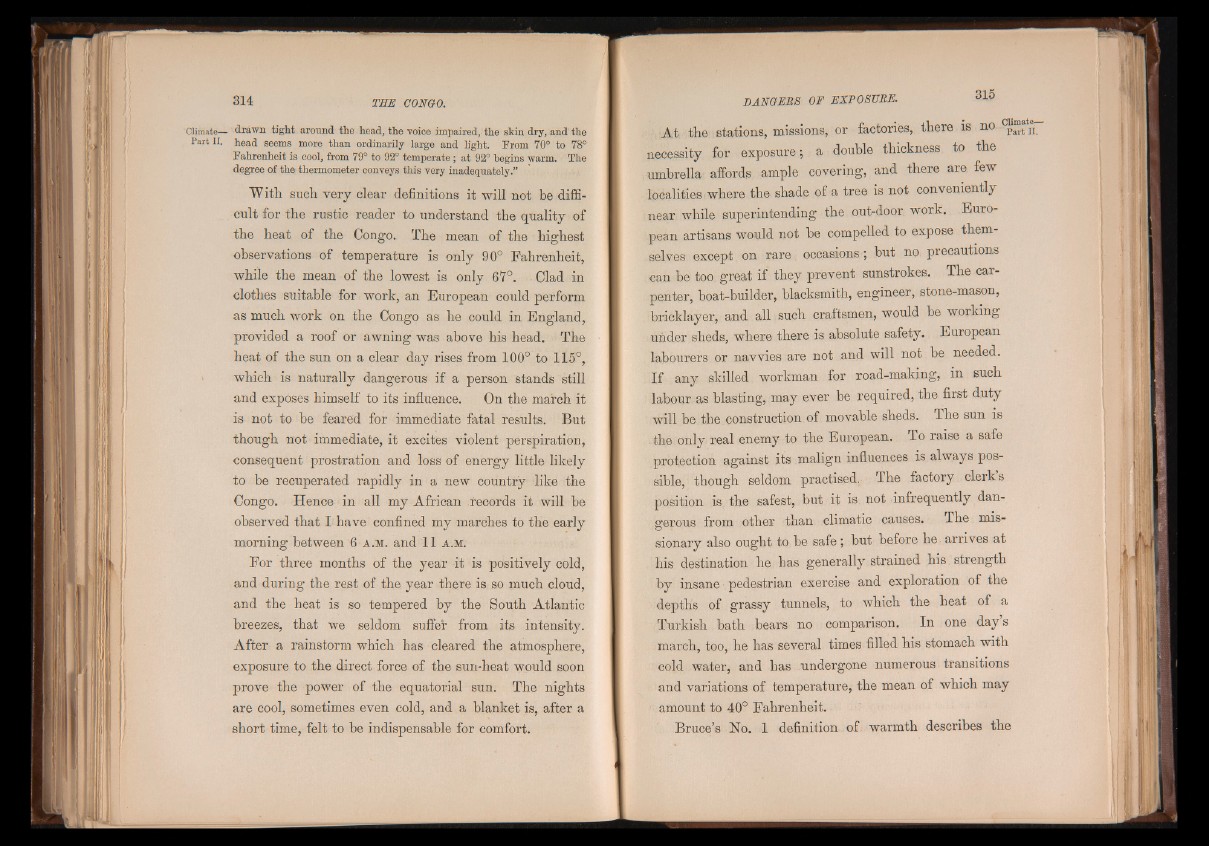
Climate— ' drawn tight around the head, the voice impaired, the skin dry, and the
Part II. head seems more than ordinarily large and light. From 70° to 78°
Fahrenheit is cool, from 79° to 92° temperate; at 92° begins warm. The
degree of the thermometer conveys this very inadequately.”
With, such very clear definitions it will not be difficult
for the rustic reader to understand the quality of
the heat of the Congo. The mean of the highest
observations of temperature is only 90° Fahrenheit,
while the mean of the lowest is only 67°. Clad in
clothes suitable for work, an European could perform
as much work on the Congo as he could in England,
provided a roof or awning was above his head. The
heat of the sun on a clear day rises from 100° to 115°,
which is naturally dangerous if a person stands still
and exposes himself to its influence. On the march it
is not to be feared for immediate fatal results. But
though not immediate, it excites violent perspiration,
consequent prostration and loss of energy little likely
to be recuperated rapidly in a new country like the
Congo. Hence in all my African records it will be
observed that I have confined my marches to the early
morning between 6 a .m . and 11 a .m .
For three months of the year it is positively cold,
and during the rest of the year there is so much cloud,
and the heat is so tempered by the South Atlantic
breezes, that we seldom suffer from its intensity.
After a rainstorm which has cleared the atmosphere,
exposure to the direct force of the sun-heat would soon
prove the power of the equatorial sun. The nights
are cool, sometimes even cold, and a blanket is, after a
short time, felt to be indispensable for comfort.
At the : stations, missions, or factories, there is no Cp“t n
necessity for exposure; a double thickness to the
umbrella affords ample covering, and there are. few
localities where the shade of a tree is not conveniently
near while superintending the out-door. work. European
artisans would not be compelled to expose themselves
except on rare occasions; but no precautions
can be too great if they prevent sunstrokes. The carpenter,
boat-builder, blacksmith, engineer, stone-mason,
bricklayer, and all such craftsmen, would be working
under sheds, where there is absolute safety. European
labourers or navvies are not and will not be needed.
If any skilled workman for road-making, in such
labour as blasting, may ever be required, the first duty
will be the construction of movable sheds. The sun is
the only real enemy to the European. To raise a safe
protection against its malign influences is always possible,
though seldom practised. The factory clerks
position is the safest, but it is not .infrequently dangerous
from other than climatic causes. The mis- - O *
sionary also ought to be safe ", but before he arrives at
his destination he has generally strained his strength
by insane pedestrian exercise and exploration of the
depths of grassy tunnels, to which the heat of a
Turkish bath bears no comparison. In one day’s
march, too, he has several times filled his stomach with
cold water, and has undergone numerous transitions
and variations of temperature, the mean of which may
amount to 40° Fahrenheit.
Bruce’s No. 1 definition of warmth describes the